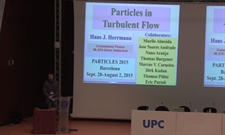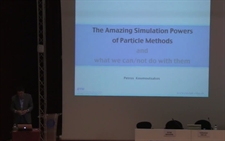PARTICLES 2015 will address both the fundamental basis and the applicability of state-of-the-art particle-based computational methods that can be effectively used for solving a variety of problems in engineering and applied sciences.
The denotation "Particle-Based Methods" basically stands for two different computational models in solid and fluid mechanics.
On the one hand it represents discretization concepts in which the response of a continuum is projected onto "particles" carrying the mechanical information during deformations. Typical representatives are Meshless Methods, Smoothed Particles Hydrodynamics (SPH), Moving Particle Simulation (MPS), Particle Finite Element Method (PFEM), Material Point Method (MPM) and the Lattice-Boltzmann-Method (LBM).
On the other hand the notion expresses the computational representation ofphysical particles existing on different scales. Classical versions are Molecular Dynamics (MD) or the Discrete (Distinct) Element Method (DEM). Here either the particles exist a priori like in granular matters or they evolve during the loading process. In some cases the two models of discretization and physical particles are even interconnected.
Visit their website: Particles 2015















